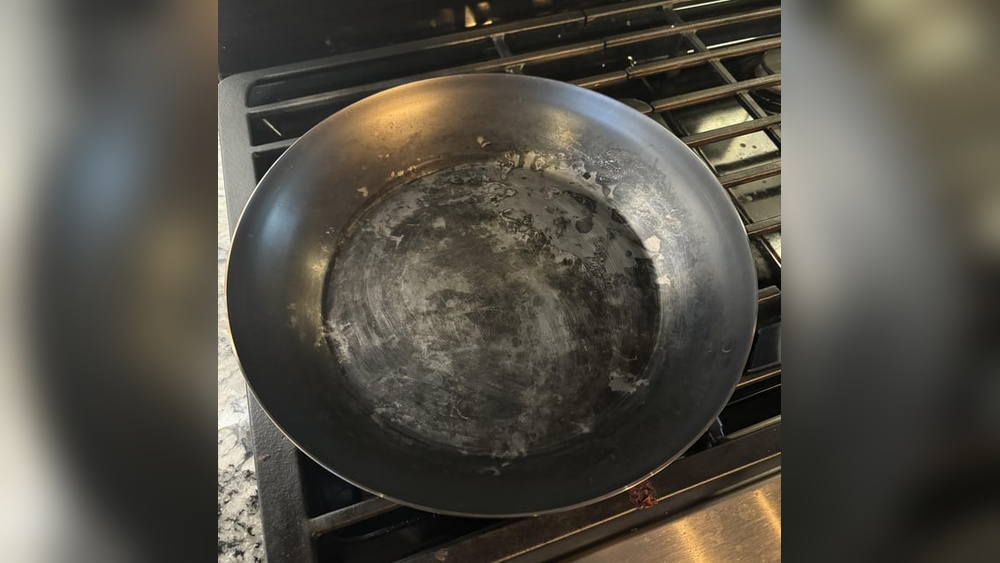If you’ve ever cooked with a carbon steel pan, you know how important it is to keep it in top shape. But over time, your pan can lose its natural non-stick surface and start to rust or stick.
That’s where reseasoning comes in. By learning how to reseason your carbon steel pan, you’ll restore its smooth, durable coating and make every meal better. In this guide, you’ll discover simple, step-by-step tips to bring your pan back to life—so you can enjoy cooking with it again and again.
Ready to make your pan like new? Let’s dive in.

Credit: www.reddit.com
Why Reseason Carbon Steel Pans
Carbon steel pans need reseasoning to keep their surface smooth and nonstick. Over time, cooking and cleaning wear down the seasoning layer. This layer protects the pan from rust and helps food cook evenly. Without reseasoning, the pan may lose its nonstick quality and can start to rust.
Reseasoning restores the protective coating. It also improves the pan’s cooking performance. Regular care extends the life of the pan. It keeps your cooking safe and simple.
Benefits Of A Well-seasoned Pan
A well-seasoned carbon steel pan resists rust and corrosion. It creates a natural nonstick surface for cooking. Food slides off easily, requiring less oil. Cooking becomes healthier and easier. Heat spreads evenly for better results. The pan lasts longer with less damage.
Signs Your Pan Needs Reseasoning
The pan’s surface looks dull or patchy. Food starts sticking more during cooking. Rust spots appear on the pan. The pan feels sticky or rough after cleaning. These signs show the seasoning is worn out. Reseasoning fixes these issues quickly.
Gathering Essential Tools
Before you start reseasoning your carbon steel pan, gather all the tools you need. Having the right supplies makes the process easier and better. This step helps you avoid interruptions and ensures good results. Let’s see what essential tools you need for reseasoning.
Choosing The Right Oil
Pick an oil with a high smoke point for reseasoning. Oils like flaxseed, grapeseed, or canola work well. These oils create a strong, durable layer on the pan. Avoid using oils that burn easily, such as olive oil. The right oil helps the pan stay non-stick and rust-free.
Additional Supplies Needed
Besides oil, gather a few other supplies. You need a clean cloth or paper towels for wiping excess oil. Use a soft sponge or brush to clean the pan before seasoning. Have oven mitts ready to handle the hot pan safely. A stove or oven is necessary for heating during the process. These simple tools make reseasoning smooth and safe.
Preparing The Pan
Preparing your carbon steel pan is the first step in reseasoning. A clean and dry surface helps the oil bond well. This makes the seasoning last longer and protect the pan from rust.
Start by removing any old residue. Then, dry the pan thoroughly. These steps ensure the best results for your reseasoning process.
Cleaning Old Residue
Use hot water and a sponge to scrub the pan. Avoid soap as it can remove the original seasoning. If residue is stubborn, add some coarse salt. Scrub with a paper towel or cloth. This acts as a gentle abrasive. Rinse the pan with warm water. Make sure all bits of food and oil are gone. Your pan should look clean and smooth.
Drying Techniques
Wipe the pan dry with a clean towel. Water left on the surface can cause rust. Place the pan on low heat for a few minutes. This evaporates any remaining moisture. Let the pan cool before adding oil. A completely dry pan helps the oil stick better. This step is key to a strong seasoning layer.
Seasoning Process Steps
Seasoning a carbon steel pan creates a natural, non-stick surface. It protects the pan from rust and improves cooking. The process involves applying oil, heating the pan, and cooling it. Repeating these steps builds a strong, durable coating. Follow each step carefully for the best results.
Applying Oil Evenly
Start with a clean, dry pan. Use a cloth or paper towel to spread a thin layer of oil. Choose oils with high smoke points, like flaxseed or vegetable oil. Cover every part, including the sides and bottom. Avoid using too much oil; a thin layer works best.
Heating Methods
Heat the pan slowly to bond the oil with the metal. Use the oven or stovetop for heating. For the oven, set it to 400°F (200°C) and place the pan upside down. On the stovetop, heat on medium until the oil smokes. This process changes the oil into a hard coating.
Cooling And Repeating
Let the pan cool completely after heating. Cooling helps the coating harden and stick well. Repeat the oiling and heating steps 3 to 4 times. Each layer adds strength and improves the non-stick surface. The more you repeat, the better the seasoning becomes.
Maintaining Seasoned Surface
Maintaining the seasoned surface of your carbon steel pan keeps it non-stick and rust-free. This layer builds up through use and proper care. Treating it gently helps the seasoning last longer. Small daily habits make a big difference.
Clean the pan with warm water and a soft sponge. Avoid harsh soaps that can strip the seasoning. Dry it completely after washing to stop rust. Lightly oil the surface after each use. This step keeps the seasoning smooth and protected.
Daily Care Tips
Rinse your pan with hot water after cooking. Use a soft brush or sponge to remove food bits. Skip the dishwasher; it damages the seasoning. Dry the pan well with a towel or on low heat. Apply a thin layer of cooking oil before storing. Store in a dry place to prevent rust.
Avoiding Common Mistakes
Do not soak your pan in water for long. Avoid cooking very acidic foods often. They can wear down the seasoning. Never use metal scrubbers that scratch the surface. Avoid cooking sprays; they create sticky residue. Re-season the pan if food starts to stick. Handle your pan gently to keep the seasoning intact.

Credit: www.reddit.com
Troubleshooting Seasoning Issues
Seasoning a carbon steel pan is not always perfect the first time. Sometimes the coating can be sticky, flaky, or even show rust spots. These issues can make cooking difficult and affect the pan’s performance.
Fixing these problems helps the pan last longer and cook better. Troubleshooting seasoning issues is key to keeping your pan in great shape. Below are some simple solutions to common problems.
Fixing Sticky Or Flaky Coating
Sticky or flaky seasoning means the oil layer did not bond well. This can happen if too much oil was used or the pan was not heated enough.
Start by washing the pan with hot water and a soft sponge. Avoid soap as it can remove seasoning. Dry the pan completely on low heat.
Apply a thin layer of oil, then heat the pan on medium-high heat until it smokes lightly. Let it cool down. Repeat this process two or three times for a smooth, even coating.
Dealing With Rust Spots
Rust spots appear when moisture stays on the pan too long. Rust weakens the pan and ruins the seasoning.
Use a fine steel wool or a scrub pad to gently remove rust spots. Rinse with warm water and dry fully on the stove.
After removing rust, reseason the pan by applying a thin oil layer. Heat the pan until the oil smokes and forms a new protective layer. This stops rust from coming back.
:max_bytes(150000):strip_icc()/__opt__aboutcom__coeus__resources__content_migration__serious_eats__seriouseats.com__2019__05__20190510-seasoning-carbon-steel-vicky-wasik-7-26892ffd80004cdb85b58a460863a712.jpg)
Credit: www.seriouseats.com
Frequently Asked Questions
How Often Should I Reseason A Carbon Steel Pan?
Reseason your carbon steel pan every 3 to 6 months. Frequent use may require more regular seasoning. Regular reseasoning maintains the non-stick surface and prevents rust.
What Oils Are Best For Reseasoning Carbon Steel Pans?
Use high smoke point oils like flaxseed, grapeseed, or vegetable oil. These oils create a durable, non-stick coating. Avoid low smoke point oils to prevent sticky residue.
Can I Reseason A Carbon Steel Pan In The Oven?
Yes, reseasoning in the oven is effective. Coat the pan with oil and bake at 400°F for one hour. This process bonds the oil to the pan surface.
How Do I Clean My Pan Before Reseasoning?
Clean the pan with hot water and a mild scrubber to remove residue. Avoid soap to preserve existing seasoning. Dry thoroughly to prevent rust before reseasoning.
Conclusion
Reseasoning your carbon steel pan keeps it cooking well and lasting long. Regular care stops rust and builds a smooth, non-stick surface. Just follow the simple steps and be patient. Each time you cook, the pan gets better. A well-seasoned pan makes food taste great and cleans easily.
Take your time and enjoy the process. Soon, your pan will become your kitchen favorite. Keep it dry and oil it lightly after use. Happy cooking with your carbon steel pan!

